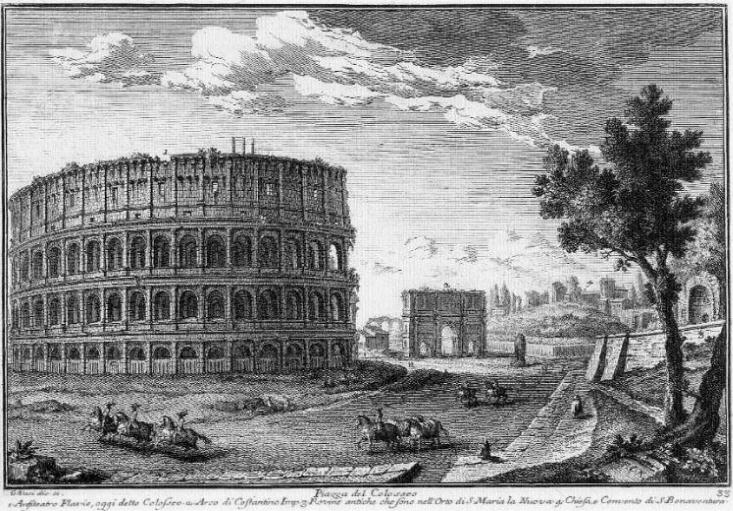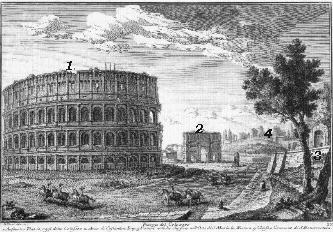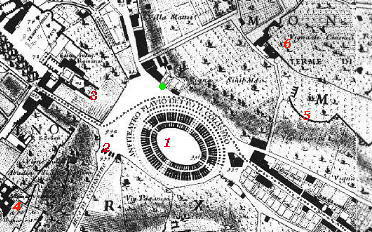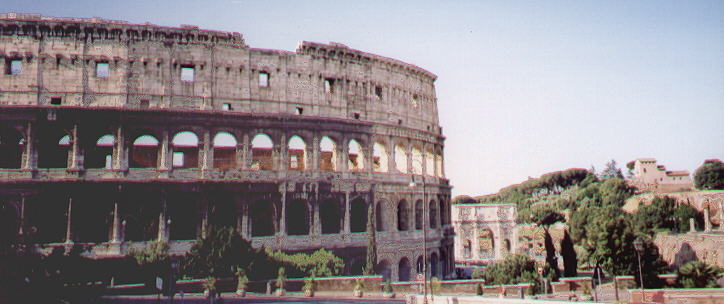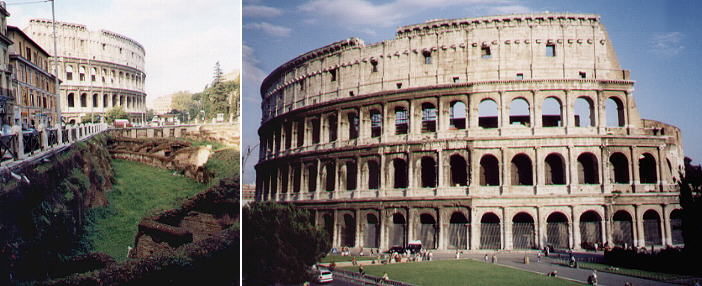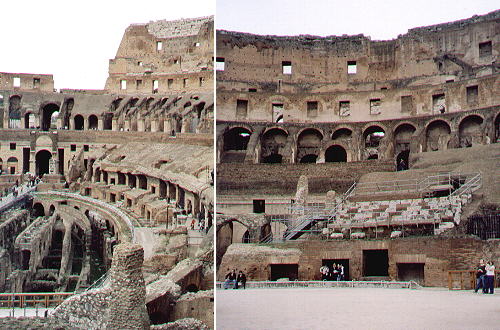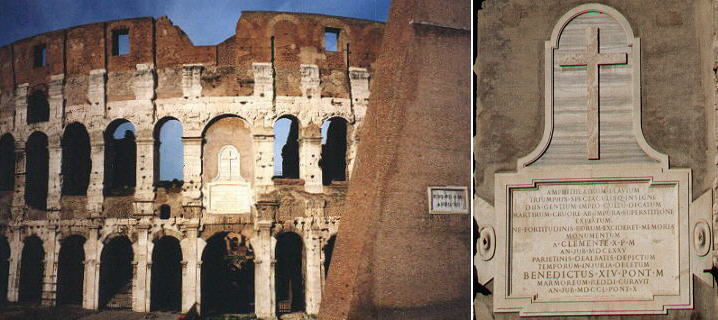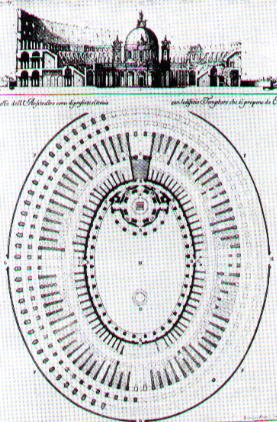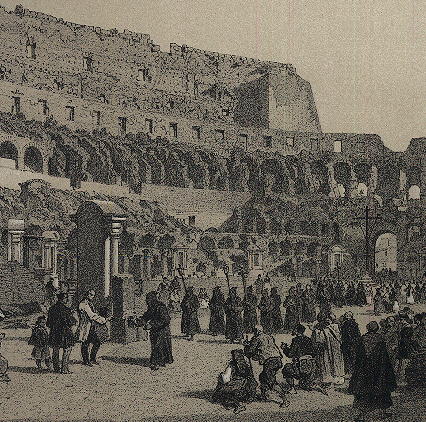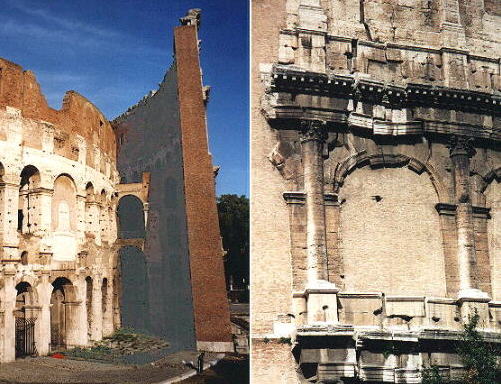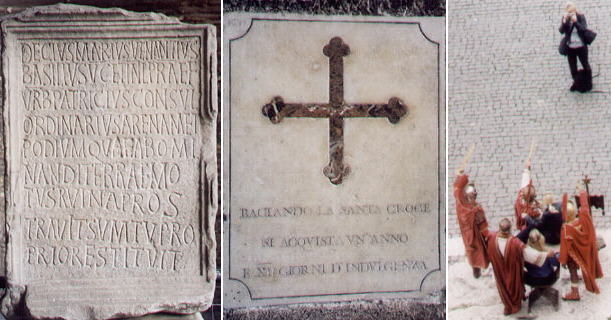  Piazza del Colosseo (Book 2) (Map B3) (Day 1) (View C9) (Rione Campitelli) and (Rione Monti) In this page:
Benedictus XIV in order to preserve the Colosseum from further damage
inhibited the access to it by closing the arches on the ground floor and
by consecrating the interior to the Passion of Christ because of the many
martyrs who died there. The view shows the northern part of the monument
which still had the outer circle. The view is taken from the green dot in the map below. In the description below the plate Vasi made reference to: 1) Anfiteatro Flavio; 2) Arco di Costantino; 3) Ruins near S. Maria Nuova (Tempio di Venere e Romolo); 4) S. Bonaventura. 4) is shown in another page. The
small 1748 map shows also 5) Domus Aurea; 6) Terme di Tito e di Traiano. The dotted line in the small map delineates the border between Rione Monti (upper part) and Rione Campitelli (lower part).
Vasi forced perspective laws to show the whole building and the Arch
of Constantine. Today the area between the Colosseum and the Forum
is pedestrian and always full of tourists.
The Colosseum (after the name of a nearby colossal statue of Nero) is more
properly called the Amphiteatrum Flavium, because it was completed by the
Emperor Titus Flavius in AD 80. Smaller buildings hosted stables, barracks
and training grounds part of which are now visible in an area excavated in the
1920s (Ludus Magnus).
The design of the Colosseum shows the skills of the Roman architects in providing effective solutions to the many problems caused by the gathering of large crowds. There were independent accesses (vomitoria) to the three tiers into which the seats were divided; this allowed an easy exit at the end of the performances. The gladiators and the beasts reached the Colosseum through underground passages and found below the arena rooms for resting and practising. A sort of awning (velarium) sheltered the spectators from the sun. Sand was strewn on the ground to reduce the effects of falls and to absorb the blood (the word rena (sand) eventually became a simpler way (arena) to refer to the amphitheatre). The picture below shows the inner circle with the inscription and the cross put by Benedictus XIV. On two occasions (Clemens X/Gian Lorenzo Bernini and Clemens XI/Carlo Fontana) the idea of erecting a church inside the Colosseum was considered: eventually under Clemens XI, fourteen stations of the Cross were built in memory of the Christian martyrs. They were re-erected in 1749, under Benedictus XIV, and pulled down in 1874 to allow the excavations of the arena.
With the consecration to the Christian Martyrs, the Colosseum became the scene of many processions and religious ceremonies, in particular during the Holy Week. These ceremonies often excited the crowds and led to assaults against the Jews. The image below is taken from a print by Philippe Benoist (series Rome dans sa Grandeur) for the joy of the XIXth century armchair traveller. The image shows that the walls were covered by a thick vegetation (more than 200 species were identified by a XIXth century botanist). The plan shows the project by Carlo Fontana for the erection of a little church inside the Colosseum.
One of the most effective action to prevent the further fall of the outer circle was completed by Pius VII with the erection of a wall which shows some of the arches in the state they were when the wall was built.
The Colosseum was damaged by earthquakes and in the Vth century only a portion of the building was used. In 438 the emperor Valentinianus III closed the gladiators' schools and the performances were limited to the hunting of wild beasts. The invasion of northern Africa by the Vandals interrupted the supply of lions and other wild animals and the last performances were based on bears from the nearby mountains. The decadence of Rome is evident in the poorly written inscription celebrating a restoration of the arena made at the beginning of the VIth century.
The Christian aspects of the Colosseum with its many crosses granting one year and eleven days of indulgence to those who kissed them are today overlooked and the Colosseum is now seen as the most impressive symbol of the Roman Empire. Read Charles Dickens's comments about the crosses of the Colosseum. Excerpts from Giuseppe Vasi 1761 Itinerary related to this page:
Next page Next plate in Book 2: Piazza
di S. Giovanni in Laterano
Go
to |
